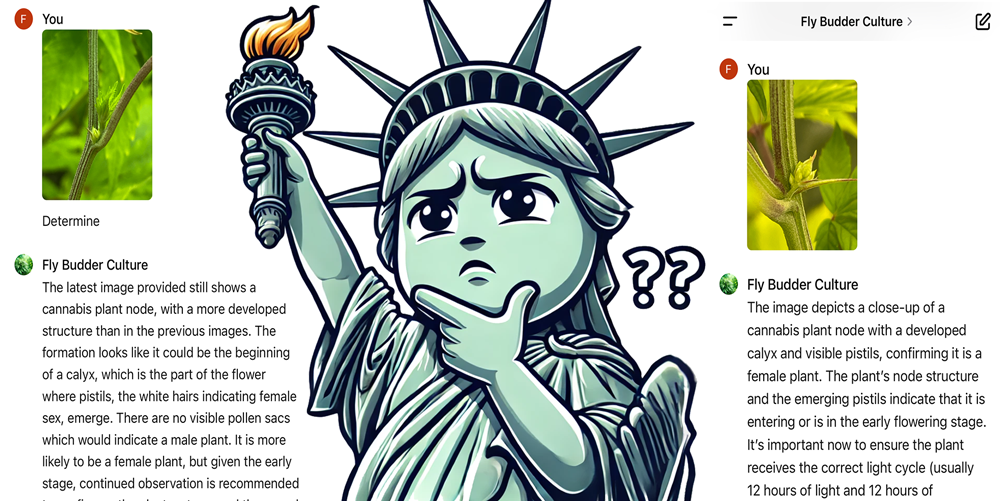Content on Fly Budder is for educational purposes only. All cultivation is conducted in accordance with applicable laws. No products, services, or items are offered or sold through this site.
My experience using ChatGPT4
As someone who has spent over 25 years in web development and design, I'm no stranger to the power of technology. When I embarked on my cannabis cultivation journey, I naturally turned to every available resource for guidance.
5/8/20244 min read


After watching countless YouTube videos from popular content creators, I found myself overwhelmed by conflicting advice and the constant push to buy sponsored products. It was then that I decided to leverage ChatGPT—a tool I had used extensively in my professional life—to assist me in navigating the complexities of growing cannabis.
The Good: A Knowledgeable Companion at My Fingertips
From the outset, ChatGPT proved to be a valuable resource. It was like having a knowledgeable companion available 24/7, ready to provide advice, answer questions, and even help troubleshoot issues as they arose. As a beginner in cultivation, I found it particularly useful for:
Quick Information Retrieval: Whether I needed to confirm the ideal pH levels for coco coir or wanted to understand the differences between various nutrients, ChatGPT provided concise and accurate answers, saving me hours of searching through forums and websites.
Problem Identification: Early on, when I encountered issues like nutrient deficiencies or environmental stress, ChatGPT was able to help me identify the likely causes based on the symptoms I described. This was incredibly helpful, as it allowed me to address problems before they became severe.
Learning at My Own Pace: Unlike YouTube videos, which often gloss over the details in favor of pushing products, ChatGPT allowed me to dive deep into topics at my own pace. I could ask follow-up questions, explore related topics, and build a solid understanding of the fundamentals of cannabis cultivation.
Overall, ChatGPT was a great tool for getting started. It helped me cut through the noise and focus on what really mattered: growing healthy plants.
The Bad: When Things Got Complicated
However, as I progressed deeper into my grow, I began to encounter limitations with using ChatGPT as my primary source of guidance. The biggest challenge came when my regular photoperiod plants began to show their sex. This is where things started to go awry.
Despite following what I believed to be solid advice, I ended up with a situation I hadn’t anticipated: my male plants pollinated the females, resulting in the unintended breeding of my other plants. As someone who was not aiming to breed but rather to cultivate sinsemilla (seedless) buds, this was initially a major disappointment.
The issue highlighted a few key shortcomings of relying on ChatGPT:
Lack of Real-Time Adaptation: While ChatGPT is great for general advice, it’s not always adept at adapting to real-time changes in your grow environment. For example, it didn’t fully prepare me for the nuances of sexing plants, which ultimately led to the accidental breeding.
Contextual Understanding: ChatGPT’s advice is only as good as the information it’s fed. If the context isn’t fully understood or accurately described, the recommendations may not align with your specific situation. In my case, I likely didn’t provide enough detail about the timing and environment, which contributed to the mishap.
Not a Replacement for Expert Knowledge: While ChatGPT is an excellent tool for learning and troubleshooting, it shouldn’t be viewed as the final word on any subject. The lack of real-world experience and hands-on expertise can sometimes lead to gaps in advice, as I experienced firsthand.
Third Grow: Coast of Maine Living Soil
For my current grow, I wanted to explore a more sustainable and organic approach, so I opted for Coast of Maine Living Soil. Living soil is teeming with microorganisms that work symbiotically with your plants, breaking down organic matter into nutrients that are readily available for uptake. This method is often considered the most natural way to grow, as it mimics the processes that occur in nature.
One of the main benefits of living soil is that it requires minimal input from the grower in terms of feeding. The soil itself is a complete ecosystem, providing all the nutrients your plants need throughout their life cycle. Additionally, living soil helps improve the flavor and aroma of the final product, as the complex interactions between the soil’s microorganisms and the plant roots lead to a richer terpene profile.
However, living soil is not without its challenges. It requires a bit more space and careful management of the soil’s health, ensuring that the microbial life remains active and balanced. Additionally, the initial cost can be higher compared to other mediums, but this is offset by the reduced need for bottled nutrients.
So far, my experience with living soil has been incredibly rewarding. The idea of cultivating a garden that is self-sustaining and closely aligned with natural growing practices resonates deeply with me, and I’m excited to see how this method enhances the quality of my current grow.
A Blessing in Disguise
Despite the initial frustration, the situation turned out to be a blessing in disguise. The accidental breeding gave me a deeper understanding of the plant’s reproductive cycle and opened up new possibilities for future grows. I began to appreciate the complexity of cannabis cultivation in ways I hadn’t before, and it sparked an interest in potentially experimenting with breeding in the future.
This experience also reinforced the importance of not relying solely on any one source of information—whether it’s ChatGPT, YouTube, or any other tool. Cultivation is as much an art as it is a science, and sometimes the unexpected can lead to valuable learning opportunities.
Moving Forward: Enhancing FlyBudder App with a Detailed Knowledge Base
As I continue to refine my cultivation skills, I’m also working on fleshing out my FlyBudder app with a detailed knowledge base before sharing it publicly. My goal is to create a resource that combines the convenience and accessibility of ChatGPT with the depth and reliability of expert-curated content. By integrating real-world experiences and proven techniques, I hope to provide a more robust tool for growers at all levels.
In conclusion, while ChatGPT has been a fantastic companion on my cultivation journey, it’s important to remember that it’s just one tool in a grower’s arsenal. It’s great for quick advice and learning the basics, but it shouldn’t be relied upon as the ultimate authority. Combining technology with hands-on experience, expert advice, and a willingness to learn from mistakes is the key to becoming a successful cultivator.
© 2025. FLY BUDDER - All rights reserved.


